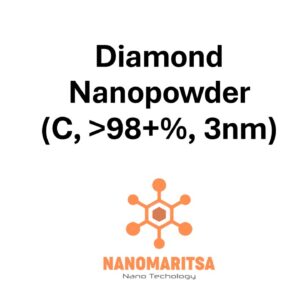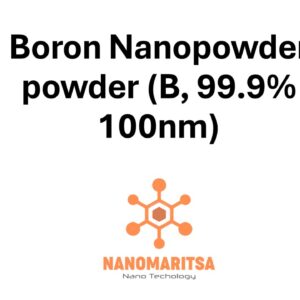Iron Nanopowder (Fe, 99.5+%, 35-45 nm) is a high-purity material with a particle size range of 35 to 45 nanometers (nm), offering unique properties when compared to bulk iron. With a purity of 99.5+%, this iron nanopowder is designed for advanced industrial, technological, and scientific applications where high material quality and specific particle characteristics are crucial. The reduced particle size enhances the reactivity, surface area, and mechanical properties of the material, making it suitable for various high-performance uses. Below is a detailed overview of its key features, properties, and applications.
Key Features:
Iron (Fe):
Iron is a widely used metal known for its magnetic properties, strength, and abundance. When reduced to nanoparticle size, iron exhibits improved reactivity, surface area, and other enhanced properties, making it suitable for use in catalysts, energy storage, and magnetic applications.
Purity (99.5+%):
The 99.5+% purity ensures minimal impurities in the iron nanopowder, which is essential for applications that require high material consistency and performance. This high level of purity makes it ideal for use in precision applications, where even small amounts of contaminants can affect functionality.
Particle Size (35-45 nm):
With a particle size of 35-45 nm, this iron nanopowder offers a high surface area, enhancing its reactivity and making it suitable for applications in catalysis, energy storage, and other fields where small particle size is beneficial. The particle size also ensures ease of dispersion in various media.
Properties:
Magnetic Properties:
Iron is a ferromagnetic material, and iron nanopowder retains these magnetic properties. The small particle size increases the magnetic susceptibility and enhances the material’s performance in magnetic applications, such as in magnetic storage, sensors, and electromagnetic shielding.
High Surface Area:
The nanoparticle form of iron significantly increases the surface area compared to bulk iron. This high surface area enhances its reactivity, making it ideal for use as a catalyst in chemical reactions or in the development of new materials and composite structures.
Thermal Stability:
Iron nanopowder exhibits good thermal stability, retaining its properties under elevated temperatures. This makes it suitable for high-temperature applications in industries such as automotive, aerospace, and electronics, where thermal performance is crucial.
Chemical Reactivity:
The small size of the iron nanoparticles increases their chemical reactivity, making them effective for use in catalysis and chemical synthesis. The increased surface area allows for more interaction with reactants, improving efficiency in chemical processes.
Electrical Conductivity:
While iron is not as conductive as copper, it still possesses good electrical conductivity. Iron nanopowder is used in applications where moderate conductivity is required, such as in electromagnetic shielding and in the production of conductive composites.
Corrosion Resistance:
Although bulk iron is prone to rusting and corrosion, iron nanoparticles exhibit improved resistance to corrosion, especially when coated or treated. This enhanced resistance makes iron nanopowder useful in applications where long-term durability and material stability are essential.
Applications:
- Magnetic Materials and Devices:
Due to its ferromagnetic properties, iron nanopowder is used in magnetic applications such as magnetic storage media, sensors, and actuators. The increased magnetic properties of the nanoparticles make them highly effective in small, precision-driven devices. - Catalysis and Chemical Synthesis:
Iron nanopowder is an effective catalyst for a variety of chemical reactions, including hydrogenation, oxidation, and Fischer-Tropsch synthesis. Its high surface area improves catalytic efficiency, making it ideal for use in industrial chemical processes, energy production, and environmental applications. - Energy Storage and Conversion:
Iron nanopowder is used in energy storage devices like batteries and supercapacitors, where its increased surface area and conductivity improve charge/discharge cycles. It can also be used in fuel cells to enhance the electrochemical reactions required for energy conversion. - Electromagnetic Shielding:
The magnetic properties and electrical conductivity of iron nanopowder make it effective in electromagnetic shielding applications. It can be used in coatings and materials designed to protect sensitive electronics from electromagnetic interference (EMI) and radio frequency interference (RFI). - Additives in Metallurgy and Alloys:
Iron nanopowder is added to metal alloys to enhance their mechanical properties, such as strength, wear resistance, and thermal stability. It is commonly used in the production of high-strength steel and other advanced metal materials for use in construction, automotive, and aerospace industries. - Biomedical Applications:
Iron nanopowder is increasingly used in biomedical applications, including drug delivery, magnetic resonance imaging (MRI) contrast agents, and magnetic hyperthermia treatments for cancer. Its magnetic properties allow it to be targeted to specific areas in the body, improving the efficacy of treatments. - Water Treatment:
Iron nanopowder is used in environmental applications, particularly in water purification and wastewater treatment. It can effectively remove contaminants such as heavy metals and organic pollutants by acting as a catalyst or through its ability to react with certain compounds. - Corrosion-Resistant Coatings:
Due to its enhanced corrosion resistance, iron nanopowder can be used in coatings and paints to protect metal surfaces from rust and degradation. These coatings are valuable in industries such as marine, automotive, and construction, where metal components are exposed to harsh environments. - Printed Electronics and Conductive Inks:
Iron nanopowder can be incorporated into conductive inks for printed electronics, offering a cost-effective alternative to silver or copper nanopowders. These inks are used in applications such as printed circuit boards (PCBs), flexible electronics, and sensors.
Handling and Safety:
Health and Safety Considerations:
Iron nanopowder should be handled with care to avoid inhalation, ingestion, or prolonged skin contact. Protective equipment such as gloves, masks, and safety goggles should be worn when handling iron nanopowder to minimize exposure to airborne particles. It is important to work in a well-ventilated area to reduce inhalation risks.
Storage:
Iron nanopowder should be stored in a cool, dry, and well-ventilated environment to prevent moisture absorption, which could cause oxidation. The container should be tightly sealed to protect the powder from air and humidity, ensuring the material’s stability and performance.
Precautions:
When handling iron nanopowder, avoid generating dust or aerosols. Work in a controlled environment, such as a fume hood, to minimize inhalation risks. Dispose of the material according to local environmental regulations to ensure safe handling and minimize environmental impact.
Summary:
Iron Nanopowder (Fe, 99.5+%, 35-45 nm) is a high-purity material that combines the beneficial properties of iron with the enhanced reactivity and surface area of nanoparticles. Its unique characteristics, such as improved magnetic properties, high surface area, and thermal stability, make it suitable for a wide range of applications in industries such as catalysis, energy storage, electromagnetic shielding, and biomedical fields. Proper handling, storage, and safety precautions are essential to maintain its performance and ensure safe use.
| Measurement (gr) | 25 grams, 100 grams |
|---|






